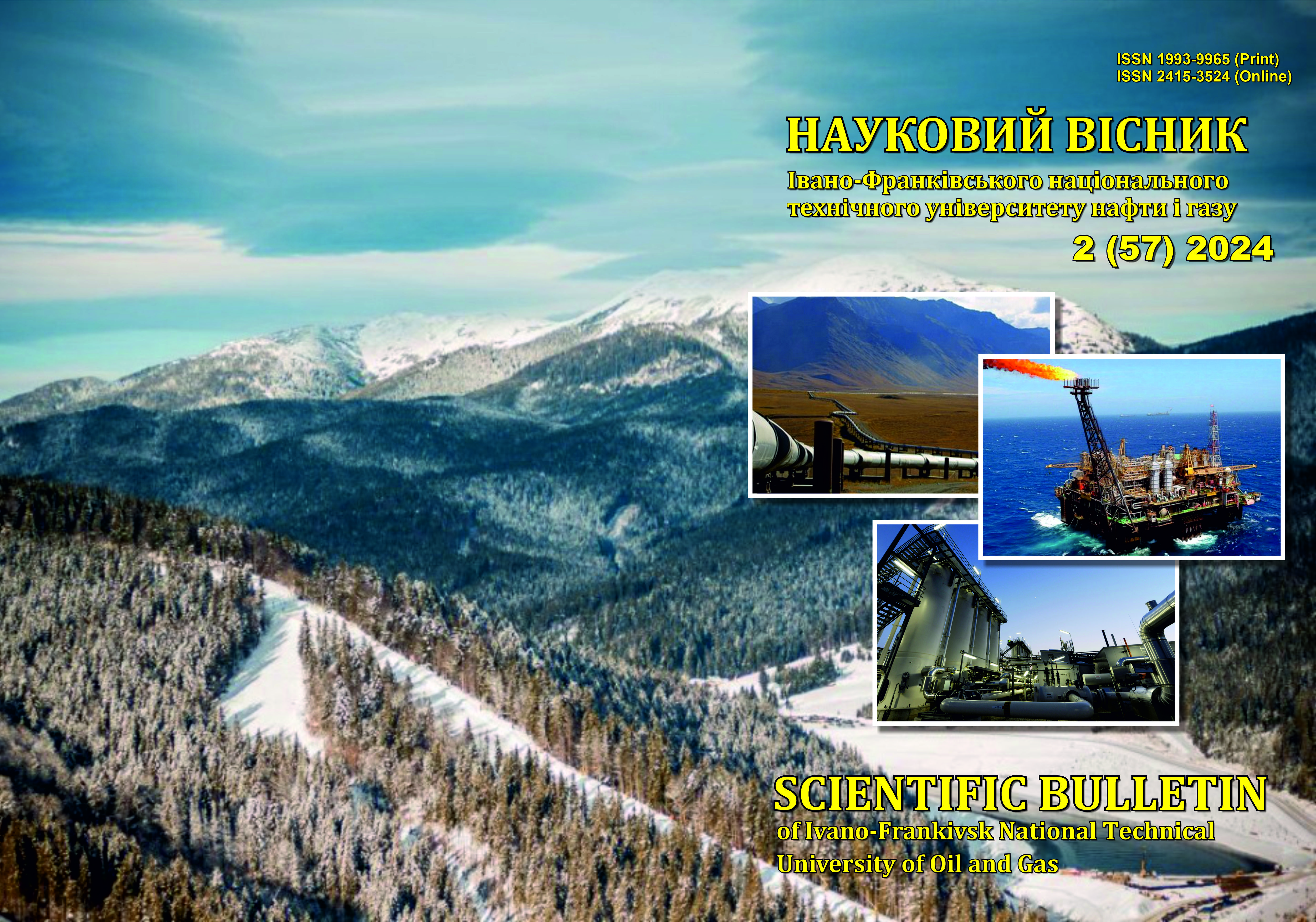RESEARCH ON THE PROPERTIES OF HEAT-RESISTANT COATINGS FORMED BY PLASMA ELECTROLYTIC OXIDATION OF ALUMINUM ALLOYS
DOI:
https://doi.org/10.31471/1993-9965-2024-2(57)-15-24Keywords:
technological process, control system, plasma electrolytic oxidation, aluminum alloy, heat-resistant coating, taper, microhardness, friction, wear, temperature.Abstract
The possibilities for using plasma electrolytic oxidation technology to create oxide heat-resistant coatings on aluminum alloys were confirmed after an investigation of strengthening techniques was completed. In a flowing electrolyte, the work aims to investigate the effects of technological modes of the plasma electrolytic oxidation process for aluminum alloys. In order to maintain the technological parameters of the plasma electrolytic oxidation process of parts in a flowing electrolyte at a specific level, a control system was developed. This system allows for the control of the electrolyte's hydrogen index and electrical resistance, as well as the ratio of electrolyte component concentrations, flow rate, current density, current ratio, and electrolyte temperature. A technological process for plasma electrolytic oxidation of aluminum deformed and cast alloys in a flowing silicate-alkali electrolyte was developed. Oxide heat-resistant coatings were formed at different values of the technological parameters of the plasma electrolytic oxidation process. The properties of oxide coatings were evaluated, respectively, by measuring the coating thickness, the taper of the samples, microhardness, wear tests and frictional heat resistance. To study the influence of the technological parameters of the plasma electrolytic oxidation process on the geometric and physicomechanical properties of samples with oxide coatings, the research was carried out with different combinations of these parameters. According to the results of the experiments, graphical dependences were constructed for the microhardness, wear and taper of the oxide coating surface on the technological parameters of the plasma electrolytic oxidation process. The influence of the technological parameters of the plasma electrolytic oxidation process was established: the ratio of the concentrations of the components (Na2SiO3/KOH), current density, flow rate, electrolyte temperature, which ensure minimal wear of the oxide coating and sufficiently high physicomechanical properties and accuracy of the shape of the parts, microhardness and wear. The results of the research showed that the operational properties of oxide coatings depend on almost all the constituent modes of the plasma electrolytic oxidation process. Samples with oxide coating were also tested for frictional heat resistance during dry friction according to the “ring-ring” scheme. It was found that the temperature in the friction zone of aluminum samples with oxide coating is lower compared to steel samples without coating, which indicates high frictional heat resistance of the oxide coating.
Downloads
References
Clyne T. W., Troughton S. C. A review of recent work on discharge characteristics during plasma electrolytic oxidation of various metals. International Materials Reviews. 2019. Vol. 64, No 3. P. 127–162. https://doi.org/10.1080/09506608.2018.1466492
Simchen F., Sieber M., Kopp A., Lampke T. Introduction to Plasma Electrolytic Oxidation—An Overview of the Process and Applications. Coatings. 2020. Vol. 10, No 7. Art. No 628. https://doi.org/10.3390/coatings10070628
Plasma Electrolytic Oxidation (PEO) Process—Processing, Properties, and Applications. / S. Sikdar et al. Nanomaterials 2021. Vol. 11, No 6. Art. No 1375. https://doi.org/10.3390/nano11061375
Kaseem M., Fatimah S., Nashrah N., Ko Y. G. Recent progress in surface modification of metals coated by plasma electrolytic oxidation: Principle, structure, and performance. Progress in Materials Science. 2021. Vol. 117. Art. No 100735. https://doi.org/10.1016/j.pmatsci.2020.100735
Student M. M., Pohrelyuk I. M. Modifi-cation of the Surfaces of Aluminum and Titanium Alloys Aimed at the Improvement of Their Wear Resistance and Tribological Characteristics. Materials Science. 2021. Vol. 57, No 3. P. 377–386. https://doi.org/10.1007/s11003-021-00552-z
Dissolution Behavior of Different Alumina Phases within Plasma Electrolytic Oxidation Coatings / F. Simchen et al. Coatings. 2022. Vol. 12, No 8. Art. No 1205. https://doi.org/10.3390/coatings12081205
The importance of type of Ti-based additives on the PEO process and properties of Al2O3–TiO2 coating / M. Hashemzadeh et al. Surfaces and Interfaces. 2023. Vol. 36. Art. No 102523. https://doi.org/10.1016/j.surfin.2022.102523
Plasma Electrolytic Oxidation (PEO) coatings on aluminum alloy 2024: A review of mechanisms, processes, and corrosion resistance enhancement / M. Gamba et al. Applied Surface Science Advances. 2025. Vol. 26. Art. No 100707. https://doi.org/10.1016/j.apsadv.2025.100707.
Shats’kyi I. P. Integral equation of the problem of crack in a shallow shell with flexible coating. Dop. Akad. Nauk Ukr. 1992. No 1. P. 46–48.
Shatskyi I. P., Makoviichuk M. V., Shcherbii A. B. Equilibrium of Cracked Shell with Flexible Coating. In Shell Structures: Theory and Applications; CRC Press: Leiden, The Netherlands, 2018. Vol. 4. P. 165–168. doi:10.1201/9781315166605-34
Stress Analysis in Damaged Pipeline with Composite Coating / M. Dutkiewicz et al. Appl. Sci. 2021. Vol. 11, No 22. Art. No 10676. https://doi.org/10.3390/app112210676
Shats’kyi, I.; Makoviichuk, M.; Shcherbii, A. Influence of a flexible coating on the strength of a shallow cylindrical shell with longitudinal crack. J. Math. Sci. 2019, Vol. 238. P. 165–173. https://doi.org/10.1007/s10958-019-04226-9
Shatskyi, I.P.; Makoviichuk, M.V.; Shcherbii, A.B. Influence of flexible coating on the limit equilibrium of a spherical shell with meridional crack. Mater. Sci. 2020. Vol. 55, No 4. P. 484–491. https://doi.org/10.1007/s11003-020-00329-w
Optical and Mechanical Properties of Layered Infrared Interference Filters / M. Bembenek et al. Sensors. 2022. Vol. 22, No. 21. Art. No 8105. https://doi.org/10.3390/s22218105
Shatskyi I., Makoviichuk M., Ropyak L., Velychkovych A. Analytical model of deformation of a functionally graded ceramic coating under local load. Ceramics. 2023. Vol. 6, No 3. P. 1879–1893. https://doi.org/10.3390/ceramics6030115
Shatskyi I., Makoviichuk M., Ropyak L. Plane deformation of contrast layered coating under local load. Procedia Structural Integrity. 2024. Vol. 59. P. 407–412. https://doi.org/10.1016/j.prostr.2024.04.058
Methodology for soft-sensor design and in-process surface conditioning in turning of aluminum alloys / T. Junge et al. Production Engineering. 2024. Vol. 18, No 2. P. 267–287. https://doi.org/10.1007/s11740-023-01260-0
Madhavi Y., Narasaiah N., Jyothirmayi A., Rama Krishna L. Influence of surface-roughness on the corrosion-fatigue behavior of MAO coated 6061-T6 Al alloy assessed in NaCl medium. Surface and Coatings Technology. 2021. Vol. 414. Art. No 127102. https://doi.org/10.1016/j.surfcoat.2021.127102
Influence of combined shot peening and PEO treatment on corrosion fatigue behavior of 7A85 aluminum alloy / Z. Ye et al. Appl. Surf. Sci. 2019. Vol. 486. P. 72–79. https://doi.org/10.1016/j.apsusc.2019.04.242
Madhavi Y., Rama Krishna L., Narasaiah N. Corrosion-Fatigue Performance of Hard Anodized and MAO-Coated 2024-T3 and 7075-T6 Aerospace Al Alloys. Trans Indian Inst Met 2021. Vol. 74, No 9. P. 2231–2243. https://doi.org/10.1007/s12666-021-02313-7
Optimization of Plasma Electrolytic Oxidation Technological Parameters of Deformed Aluminum Alloy D16T in Flowing Electrolyte / L. Ropyak et al. Ceramics. 2023. Vol. 6, No 1. P. 146–167. https://doi.org/10.3390/ceramics6010010
Development of an Oxide Layer on Al 6061 Using Plasma Arc Electrolytic Oxidation in Silicate-Based Electrolyte / P. Jadhav et al. Materials. 2022. Vol. 15, No 4. Art. No 1616. https://doi.org/10.3390/ma15041616
Design of a Two-Layer Al–Al2O3 Coating with an Oxide Layer Formed by the Plasma Electrolytic Oxidation of Al for the Corrosion and Wear Protections of Steel / L. Ropyak et al. Progress in Physics of Metals. 2023. Vol. 24, No 2. P. 319–365. https://doi.org/10.15407/ufm.24.02.319
Chaurasiya V., Wakif A., Shah N. A., Singh J. A study on cylindrical moving boundary problem with variable thermal conductivity and convection under the most realistic boundary conditions. International Communications in Heat and Mass Transfer. 2022. Vol. 138. Art. No 106312. https://doi.org/10.1016/j.icheatmasstransfer.2022.106312
Bandura A. I., Skaskiv O. B. Boundedness of L-index in direction of functions of the form f(〈z, m〉) and existence theorems. Matematychni Studii. 2014. Vol. 41, No. 1. P. 45–52. http://matstud.org.ua/texts/2014/41_1/45-52.pdf
Bandura A., Skaskiv O. Functions Analytic in the Unit Ball Having Bounded L-Index in a Direction. Rocky Mountain Journal of Mathematics. 2019. Vol. 49, No. 4. P. 1063–1092. https://doi.org/10.1216/RMJ-2019-49-4-1063
Bandura A., Salo T., Skaskiv O. L-Index in Joint Variables: Sum and Composition of an Entire Function with a Function With a Vanished Gradient. Fractal and Fractional. 2023. Vol. 7, No 8. Art. No 593. https://doi.org/10.3390/fractalfract7080593
Čanić S. Moving Boundary Problems. Bulletin (New Series) of the American Mathe-matical Society. 2021. Vol. 58, No 1. P. 79–106. https://doi.org/10.1090/bull/1703
PEO-Chameleon as a potential protective coating on cast aluminum alloys for high-temperature applications / A Shirani et al. Surface and Coatings Technology. 2020. Vol. 397. Art. No 126016. https://doi.org/10.1016/j.surfcoat.2020.126016
Energy-efficient PEO process of alumi-nium alloys / E. Matykina et al.. Materials Letters. 2014. Vol. 127. P. 13–16. https://doi.org/10.1016/j.matlet.2014.04.077
Kaseem M., Dikici B. Optimization of Surface Properties of Plasma Electrolytic Oxida-tion Coating by Organic Additives: A Review. Coatings. 2021. Vol. 11, No 4. Art. No 374. https://doi.org/10.3390/coatings11040374
Songur F., Arslan E., Dikici B. Taguchi optimization of PEO process parameters for corrosion protection of AA7075 alloy. Surface and Coatings Technology. 2022. Vol. 434. Art. No 128202. https://doi.org/10.1016/j.surfcoat.2022.128202
Application Number SK2023000018. Connection of Pulsed dc Source for Plasma Electrolytic Oxidation. Application Date 14.02.2023. Publication Number 202300018. Publication Date 11.10.2023. Grant Number 9975. Grant Date 28.02.2024. Publication Kind Y1. IPC C25D 11/00, H03K 3/00. Applicants Zilinska univerzita v Ziline, Slovakia. Inventors: Kajanek D., Belany P., Pastorek F., Jackova M. https://patentscope.wipo.int/search/en/detail.jsf?docId=SK410757800&_cid=P12-LYWX68-78029-3
Application Number US20220056608. Plasma Electrolytic Oxidation Apparatus and Method of Plasma Electrolytic Oxidation Using the Same. Application Date 17.08.2021. Publication Number 20220056608. Publication Date 24.02.2022. Grant Number 11555253. Grant Date 17.01.2023. Publication Kind B2. IPC C25D 11/00, C25D 21/12. Applicants Korea Institute of Science and Technology. Inventors: Hun-su L., Jaewoo K., Un-Seok J., Yoonsang K., Yongchae J., Jaesang Y., Yongseok C. https://patentscope.wipo.int/search/en/detail.jsf?docId=US351844000&_cid=P12-LYWX68-78029-8
Downloads
Published
How to Cite
Issue
Section
License
Авторські права....


1.png)

















